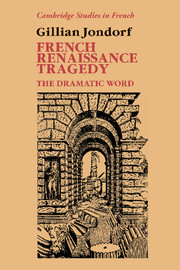6 - Shape
Published online by Cambridge University Press: 22 September 2009
Summary
In discussing humanist tragedies I am not concerned with ranking them, but with pointing to merits in plays some of which I believe to have been undervalued. I shall continue to do that in this chapter, while returning to the question of 'tenor' and 'vehicle' which I raised in the Introduction (5). If humanist tragedies are intended to convey a 'message' - which it would perhaps be less tendentious to call the idée maîtresse of a play - what means are used to present it, apart from the use of the Chorus for moralising or generalising, and sometimes for pronouncing explicit judgement, as discussed in Chapter 4?
Some commentators have implied that the moral content of a play is located mainly or almost exclusively in the sententious passages (Willner, 1932; and there are suggestions of this idea, though much less crudely put, in Charpentier, 1979, 51). But since the sententious passages often take the form of stichomythic arguments, there has also been put forward a counter-argument that no consistent thesis or attitude can be perceived in a play where rival viewpoints are allowed to come into forceful and unresolved opposition (Griffiths, 1962).
- Type
- Chapter
- Information
- French Renaissance TragedyThe Dramatic Word, pp. 111 - 130Publisher: Cambridge University PressPrint publication year: 1990



